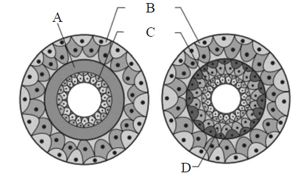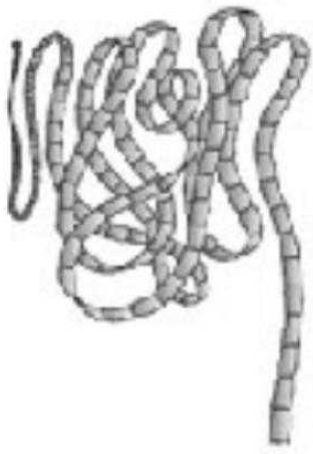Identify the animals shown in the given figures A, B and C from options given below.

A - Octopus; B -Asterias, C- Ophiura
A - Asterias; B - Ophiura, C- Octopus
A - Echinus; B - Octopus C - Ophiura
A - Ophiura; B - Echinus, C- Octopus
Correct Answer :
A. A - Octopus; B -Asterias, C- Ophiura
Octopus (also called devil fish) belongs to molluscs. Asterias (Pentaceros) is a genus of the Asteriidae family of sea stars. Ophiura albida is a species of brittle star in the order Ophiurida of Echinodermata phylum.
Related Questions
Which of the following statements is without exception in sponges ?
They all have calcareous spicules.
They have high regenerative power.
They are found only in marine water.
They are all radially symmetrical.
Which of the following characteristic is probably most responsible for the great diversification of insects on land ?
Segmentation
Antennae
Bilateral symmetry
Exoskeleton
Column-I contains organisms and column-II contains their exeretory structures. Choose the correct match form the options given below.
| Column- I | Column -II |
|---|---|
| (Organism) | (Excretory structures) |
| A. Cockroach | I. Nephridia |
| B. Cat fish | II. Malpighian tubules |
| C. Earthworm | III. Kidneys |
| D. Balanoglossus | IV. Flame cells |
| E. Flatworm | V. Proboscis gland |
A I; B III; C II; D IV; E V
A III; B I; C II; D V; E IV
A II; B I; C III; D V; E IV
A II; B III; C I; D V; E IV
Select the incorrect feature of mollusca from the given statements.
- Terrestrial or aquatic animals having cellular system level of organization.
- Radial symmetrical and acoelomate animals and possesses two germinal layers.
- A file like rasping organ called radula is present.
- Usually dioecious and viviparous animals.
- Examples include Pila, Octopus, and Dentalium.
(i) and (ii) only
(ii) and (iv) only
(i), (ii) and (iv) only
All the five statements.
Match the types of animals given in column I with their examples given in column II and choose the correct option.
| Column -I | Column -II |
|---|---|
| (Types of animals) | (Examples) |
| A. Limbless reptiles | I. Elephant |
| B. Jawless vertebrates | II. Lamprey |
| C. Flightless bird | III. Ichthyophis |
| D. Largest | IV. Ostrich terrestrial animal |
| E. Limbless amphibia | V. Cobra |
A II; B V; C IV; D I; E III
A V; B II; C IV; D I; E III
A V; B II; C I; D IV; E III
A V; B IV; C II; D I; E III
The transition from aquatic to terrestrial lifestyles required many adaptations in the vertebrate lineage. Which of the following is not one of those adaptations ?
Switch from gill respiration to air-breathing lungs.
Improvements in water resistance of skin.
Alteration in mode of locomotion.
Development of feathers for insulation.
Which of the following is a poisonous snake?
Naja (Cobra)
Bangarus (Krait)
Viper (Viper)
All of these
Which of the following is not a characteristic of phylum echinodermata ?
They have a water vascular system.
They have an internal skeleton.
They are protostomes.
They have bilateral symmetry at larval stage.
Which of the following is a correct match of a phylum with their three examples?
PlatyhelminthesPlanaria, Schistosoma, Enterobius
Mollusca Loligo, Sepia, Octopus
Porifera Spongilla, Euplectella, Pennatula
Cnidaria Bonellia, Physalia, Aurelia
Aquatic annelids (like Nereis) possess lateral appendages called ______________, which help in swimming.
visceral hump
parapodia
radula
spicules
Which of the following is not the common fundamental feature for animal classification?
Germinal layers.
Pathway of water transport.
Pattern of organization of cells.
Serial repetition of the segments.
When any plane passing through the central axis of the body divides the organism into two identical halves, the organism is called ___________.
radially symmetrical
bilaterally symmetrical
asymmetrical
metamerically segmented
The figure given below shows the germinal layers marked as A, B, C and D. Identify the label showing undifferentiated layer and its location?

A, Between B & C
B, Between A & C
C, Between C & D
D, Between A & B
Identify the correct characteristic feature shown by the given figure?

Diploblastic in nature.
Having radial symmetrical body.
Dioecious with direct development.
Presence of sensory tentacles on anterior head region.
Which of the following is a connecting link between invertebrates and non-invertebrates?
Sphenodon
Balanoglossus
Tadpole larva
Crocodile
Which of the following statement(s) is/are correct for class amphibia?
(i) Body is divisible into head and trunk.
(ii) Respiration is through gills only.
(iii) The heart is two chambered i.e. one auricle and one ventricle.
(iv) Fertilization is internal.
Only (i)
Only (iv)
(i), (ii) and (iii)
All of these
Few cnidarians like corals have a skeleton composed of
calcium hydroxide
calcium sulphate
calcium carbonate
sodium bicarbonate
Identify the figure with its correct name and phylum.

Cucumaria – Echinodermata
Ascidia – Urochordata
Balanoglossus – Hemichordata
Hirudinaria – Annelida
Which of the following is a fresh water sponge?
Sycon
Euspongia
Spongilla
Pleurobrachia
Match the terms/feature given in column I with their examples given in column II and select the correct match from the option given below.
| Column-I | Column-II |
|---|---|
| (Term/Feature) | (Examples) |
| A. Gregarious pest | i. Hirudinaria |
| B. Vector | ii. Planaria |
| C. Oviparous with | iii. Sepia indirect development |
| D. Metameres | iv. Aedes |
| E. High regeneration | v. Locust capacity |
A - i, B - ii, C - iii, D - iv, E - v
A - iii, B - v, C - ii, D - iv, E - i
A - iii, B - i, C - v, D - ii, E - iv
A - v, B - iv, C - iii, D - i, E - ii
In phylum echinodermata, the adult echinoderms are ______A__________ but larvae are _______B______ .
A radially symmetrical; B bilaterally symmetrical
A bilaterally symmetrical; B radially symmetrical
A bilaterally symmetrical; B asymmetrical
A metamerically segmented; B asymmetrical
Match the features given in column I with their examples given in column II and choose the correct match from the option given below.
| Column-I | Column-II |
|---|---|
| (Features) | (Examples) |
| A. Pseudocoelomates | a. Hydra, Adamsia |
| B. Diploblastic | b. Ctenoplana, Aurelia |
| C. Cellular level of | c. Ascaris, Wuchereria organization |
| D. Radial symmetry | d. Sycon, Spongilla |
| E. Metamerism | e. Pheretima, Neries |
A - e, B - b, C - d, D - c, E - a
A - c, B - a, C - d, D - b, E - e
A - b, B - a, C - c, D - e, E - d
A - c, B - b, C - d, D - a, E - e
Meandrina (brain coral) belongs to phylum
porifera
coelenterata
ctenophora
platyhelminthes
Hemichordates have now been placed with the nonchordates, close to echinoderms, because true
notochord is absent.
pharyngeal gill-slits are lacking.
dorsal nerve cord is absent.
heart is lacking.
Which one of the following groups of animals is correctly matched with its characteristic feature without even a single exception ?
Reptilia : possess 3 - chambered heart with one incompletely divided ventricle.
Chordata : Possess a mouth provided with an upper and lower jaw.
Chondrichthyes : Possess cartilaginous endoskeleton.
Mammalia : Give birth to young one.
Match the organisms given in column-I with their common name given in column-II and choose the correct option.
| Column -I | Column -II |
|---|---|
| (Organisms) | (Comman name) |
| A. Pennatula | I. Sea-lily |
| B. Antedon | II. Sea- pen |
| C. Echinus | III. Sea-urchin |
| D. Cucumaria | IV. Sea - cucumber |
A II; C III; D I; E IV
A II; C IV; D I; E III
A II; C I; D III; E IV
A II; C I; D III; E IV
In which of the phylum, excretory organ like proboscis gland is present?
Hemichordata
Chordata
Echinodermata
Annelida
Polyp phase is absent in
Hydra
Aurelia
Physalia
Obelia
Which of the following statements (i - v) are correct ?
(i) The pelvic fins of female sharks bear claspers.
(ii) In Obelia, polyps produce medusae sexually and medusae form the polyps asexually.
(iii) Flame cells in platyhelminthes help in osmoregulation and excretion.
(iv) In non-chordates, central nervous system is ventral, solid and double.
(v) Pinnae are present in mammals.
(ii), (iv) and (v)
(i), (iii) and (v)
(iii), (iv) and (v)
(i), (ii) and (iii)
Identify the figure with its correct name and phylum.

Sycon - Porifera
Aurelia - Coelenterata
Pleurobrachia - Ctenophora
Tapeworm - Platyhelminthes
